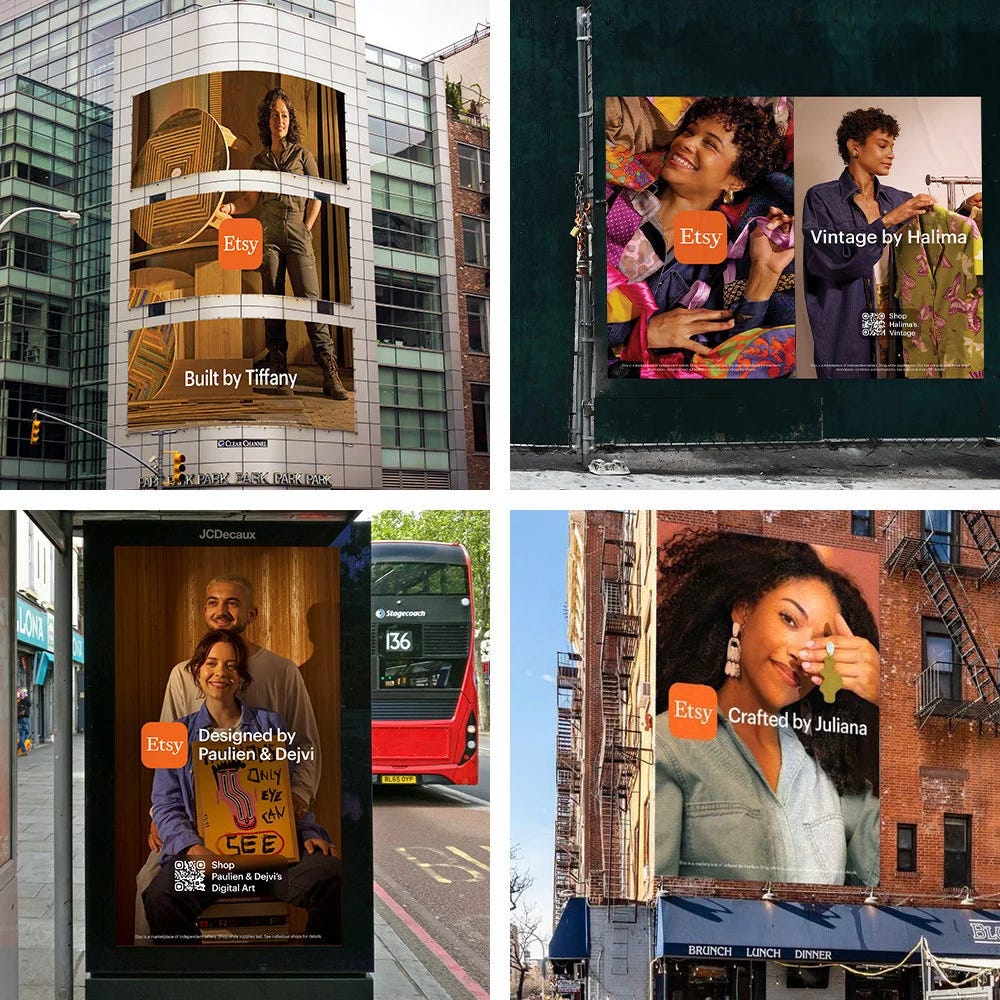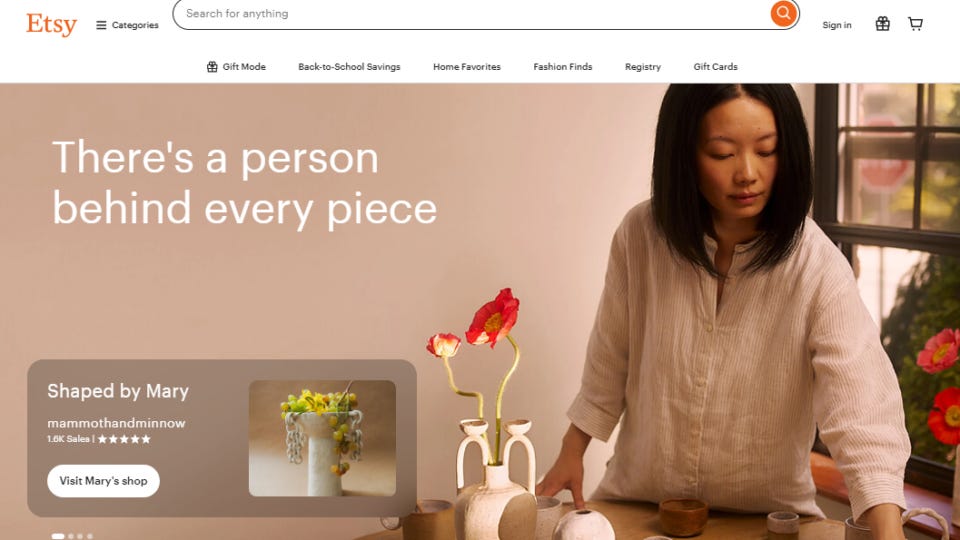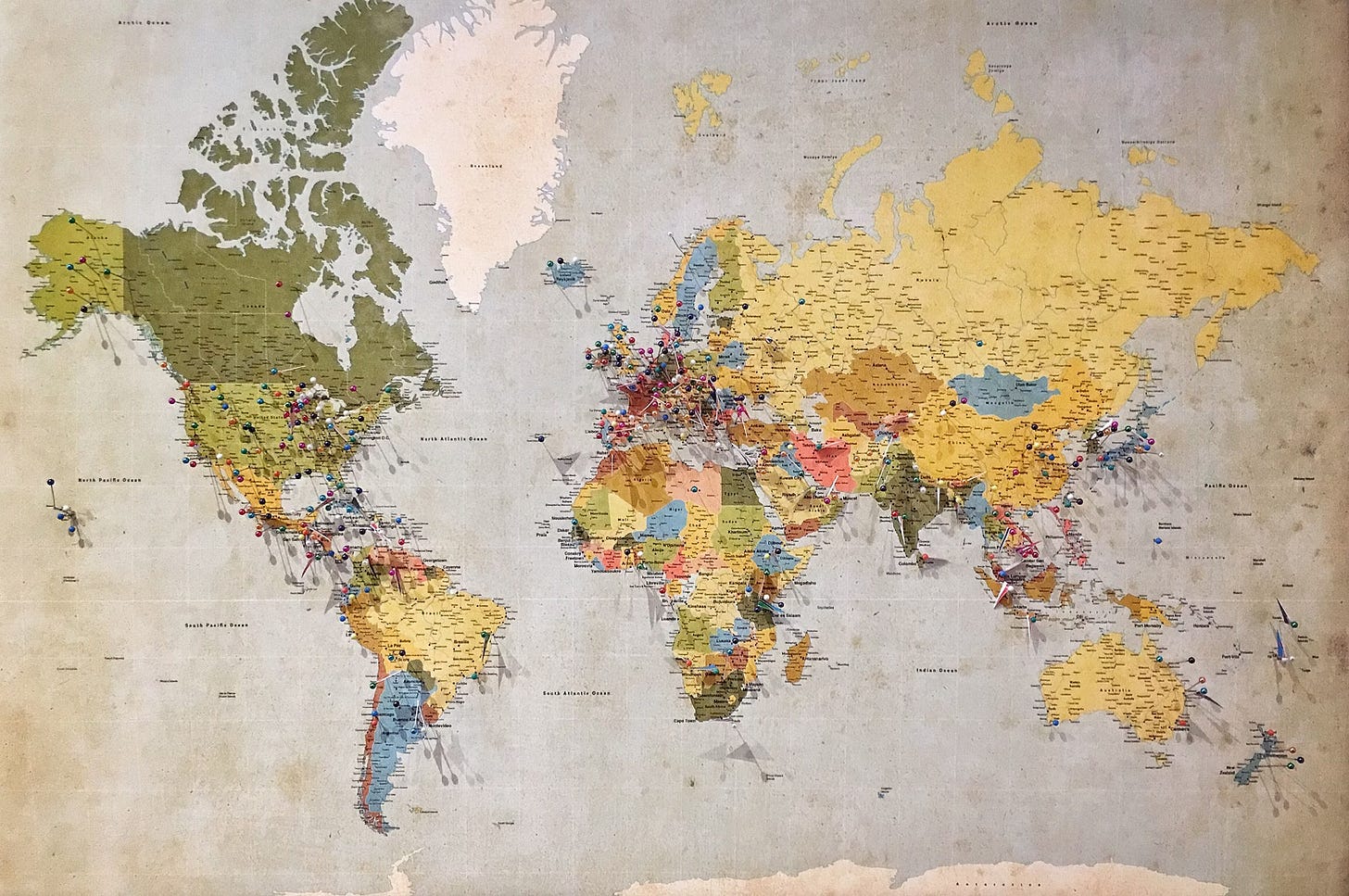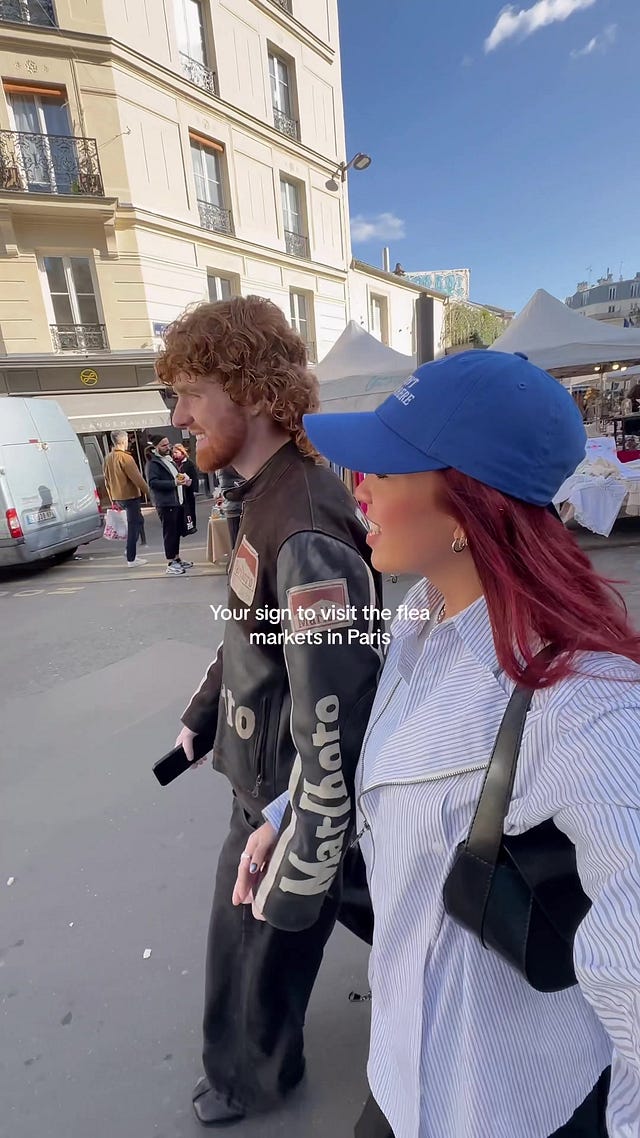Etsy Can Do Better: Reimagining Etsy's Brand Strategy
the art of the find & making online shopping fun again
Hello, my dear brand nerds,
I'm back with another creative exercise, this time inspired by my recent deep dives into Etsy.
As an avid explorer of the platform, I've spent countless hours searching for vintage home decor, cameras, and artisanal items from around the world. There's something magical about picking out a handwoven Moroccan rug, an Indian block print fabric made completely by hand, or a funky Japanese lantern that no one else is likely to have.
But in the past few years, Etsy seems to be grappling with an identity crisis. A recent CNBC report titled "Has Etsy Lost Its Way?" highlights the growing concerns among both sellers and buyers about the platform's direction.
The weird thing is, people (artists and buyers) have been telling them for YEARS what they want to see. Just a quick look at the /Etsy Reddit thread can tell you so much:
Reddit user @lnosh points out, "...loosening the definition of 'Handmade' has been its downfall. It spawned more drop shippers, and more 'contract shops'... Why buy on Etsy when you can buy the same products elsewhere? It's still possible to find handmade shops on Etsy, but you really have to search for it."
User @meh762 proposes, "I would love to see a certified handmade option. It would allow people to filter their searches if they're truly looking for handmade vs production partner."
And user @-leeson sums it up perfectly: "I go to Etsy to support small businesses and to get handmade items, etc. that's the WHOLE APPEAL."
It seems Etsy has been listening... sort of. They've recently rolled out some changes in an attempt to address these exact concerns. Let's take a quick look at what they're up to:
Etsy's New Ad Campaign & Updates
They’ve got Etsy billboards plastered across cities, featuring real sellers and their creations. TV ads showcasing artisans at work. It's all part of Etsy's latest charm offensive, aimed at reminding us why we fell in love with the platform in the first place.
(Sidenote: Here’s a great report on all the new updates they’re rolling out, as well as context — the pandemic era growth c/o sales of handmade masks, going public, new board members, “handmade doesn’t scale” (!), etc.)
Etsy's also introduced new product labels: "Made by a seller," "Designed by a seller," "Sourced by a seller," and "Handpicked by a seller." The idea? To clarify just how "handmade" each item really is.
Sounds great, right? Well, I was hopeful, but truthfully, I'm a bit… underwhelmed. It feels like a glossy pink band-aid on an infection—nice to look at, but not really addressing the deeper issues. And the new categories seem more like a cop-out than a clear solution, and I'm left feeling more confused than ever.
But as we consider Etsy's challenges, we must also ask broader questions. When a creator designs a product digitally and a machine fabricates it, is it still 'handmade'? How do Etsy's policies reflect - or fail to reflect - these technological changes? The very definition of 'handmade' is evolving, and Etsy's struggle may be symptomatic of this larger shift in craft and creation.
But what if we shift our focus from labeling/categorizing items, and instead, shift it towards the experience of a customer who loves buying handmade and unique things?
Here's where my brain wandered during my son's nap time:
The core concept? "The Joy of The Hunt."
Let's make the experience feel like digging through a craft fair, a vintage bazaar, an estate sale.
How I’d Do It: ‘The Joy of The Hunt’
Brand touches everything (I cannot overstate this), and I could go on and on about every aspect of Etsy's business. But to keep things focused (and to respect my son's nap time), I honed in on three key areas where I think "The Joy of The Hunt" could have the most impact:
Brand as Product: How can we design the hunt into the website and search experience itself?
Brand as Strategy: How might this concept shape Etsy's marketing, partnerships, and policies?
Brand as Language: How might the words and stories Etsy uses reflect and reinforce this concept?
Now, let's dive into some specific ideas for each of these areas. Remember, these are just starting points - the kind of "what ifs" that could spark bigger conversations and innovations. Here's what I came up with:
Brand as Product:
Designing the Hunt into the Website
Okay, first off - my favorite part of brand strategy is that it allows you—no, requires you—to design what the customer experiences. It’s not the logo, it’s not the tagline. It’s how people experience the product, or in this case, the platform.
🗺️ Treasure Map Interface:
This feels easy and obvious enough, but to emphasize the feel of a hunt—how about reimagining the search experience as an interactive map where users can explore the works of artisans by country?
Can’t afford to fly to flea markets in Paris? Hop on over to Etsy and click the Paris pin instead. Interested in what cool stuff is coming out of your hometown? Have a ‘hometown heroes’ feature in the map.
The assignment is not so much making discoverability more efficient, but making it MORE FUN & INTERESTING.
🔍 Storyteller Showcase:
Right now, when you upload a product on Etsy, it asks you to provide the usual—title, description, photos, tags, price. What if we added a specific (required!) field called "Note from the Maker" to each product upload page, sharing the inspiration, creation process, or origin story?
But you can’t stop there: the the product page design itself must be designed to HIGHLIGHT this note from the maker, so as to incentivize both sellers and buyers to connect the product with a human and their story. (Think of those charming staff recommendation cards in bookstores or libraries.)
💎 Hidden Gems Feature:
Now THIS I’m excited about. What if we introduced a "Surprise Me" button that leads users to a random unique item from a lesser-known or featured artisan shop, promoting discovery of new artisans?
Brand as Strategy:
Marketing the Hunt
🎫 “Golden Ticket” Launch Campaign:
Let’s say we were doing a big PR launch of this campaign. Imagine hiding "Golden Tickets" in random orders during the launch period, offering winners exclusive experiences like studio tours or co-creation opportunities with top artisans.
Orrrr: What about organizing virtual (or physical!) scavenger hunts where participants solve clues to find rewards? These can range from special handmade items, or a chance to attend an artisan workshop, or get Etsy gift cards.
🏡 Tastemaker Collaborations:
Currently, Etsy does curator collabs, but with personalities that may not align closely with Etsy's core values. Tan France? Drew Barrymore?
I mean, I guess their follower numbers might make some sort of sense, but hear me out—what if instead of TV celebrities, Etsy partnered with respected tastemakers in the handmade and vintage space instead?
Picture something like Architectural Digest's YouTube series of ‘design-offs’ (see video below), but with 4 interior design enthusiasts like Alyssa Coscarelli, Shea McGee, Emily Henderson, and Paige Wassel decorating a hypothetical room with PURELY Etsy finds.
Note: The Studio McGee x Target line sells like gangbusters, so I think aligning with her (or someone like her) can be a really good call.
They can do this with fashion tastemakers, too—shopping purely handmade or secondhand accessories on Etsy as a Tiktok/Instagram challenge sounds like an extremely fun and deep well of content.
Brand as Language:
Speaking the Language of Discovery
 Tiktok failed to load.
Tiktok failed to load.Enable 3rd party cookies or use another browser
🔍 "Find Me on Etsy" & "Found It On Etsy":
I kind of love the idea of pairing these phrases:
"Find Me on Etsy" would be for sellers—something to incorporate as a hashtag, a hyper-local campaign, or as badges/signs during craft fairs.
Meanwhile "Found It On Etsy" would be for buyers: Imagine if this became a badge of honor, a way to show off your unique taste and your ability to uncover hidden gems.
👀 Discovery-Focused Microcopy:
What if we replaced generic button text with more playful, hunt-themed language? "Search" could become "Explore," inviting users to embark on a journey of discovery every time they visit the site.
🎨 Artisan-Centric Terminology:
How about rebranding sellers as "Creators" or "Artisans" and buyers as "Collectors" or "Discoverers"? It could reinforce the special nature of Etsy transactions and make every purchase feel like acquiring a piece of art.
😈 Why I Think This Can Work
In the world of e-commerce, everyone's obsessed with efficiency. Amazon's all about getting you what you want as fast as possible. Instagram's turning your feed into a never-ending product catalog. It's all so... predictable.
But what if online shopping could be FUN again?
That's where Etsy could really shine. Forget about just making discoverability more efficient - Etsy's real opportunity is to make it a BLAST.
Imagine an Etsy where every search feels like you're embarking on a treasure hunt. Where the joy isn't just in buying, but in the thrill of discovering.
This isn't your typical e-commerce experience. This is shopping reimagined as an adventure. It's about the excitement of exploration, the delight in the unexpected.
By embracing this playful, fun-first approach, Etsy could set itself apart in a sea of sameness. While Shopify empowers sellers to set up their own stores and Chairish curates high-end vintage finds, Etsy could be the place where shopping feels like play.
No other marketplace can claim to be the "fun one." Amazon's efficient, sure, but when's the last time you described browsing Amazon as a rollicking good time?
Etsy has the chance to own this space, to be the platform that puts the joy back into the journey of discovery.
The challenge for Etsy is clear: don't just make shopping easier - make it an actually delightful experience.
In a world where every other platform is trying to streamline and optimize, Etsy can be the one that says, "Hey, remember when shopping used to be A FUN ACTIVITY? Let's bring that back, but make it even better."
What do you think? Can Etsy still be saved? Is there a way for the platform to recapture its original magic while still thriving in today's competitive e-commerce landscape? Or are we simply nostalgic for a version of Etsy that can no longer exist in our current economic reality?
The answers aren't clear. But I think as long as there are people seeking unique, handmade treasures – and artisans eager to create them – there will be a need for platforms like Etsy. Whether Etsy itself can continue to fill that need remains to be seen.
Thanks for nerding out with me this week. ‘Til next time,
Arriane










